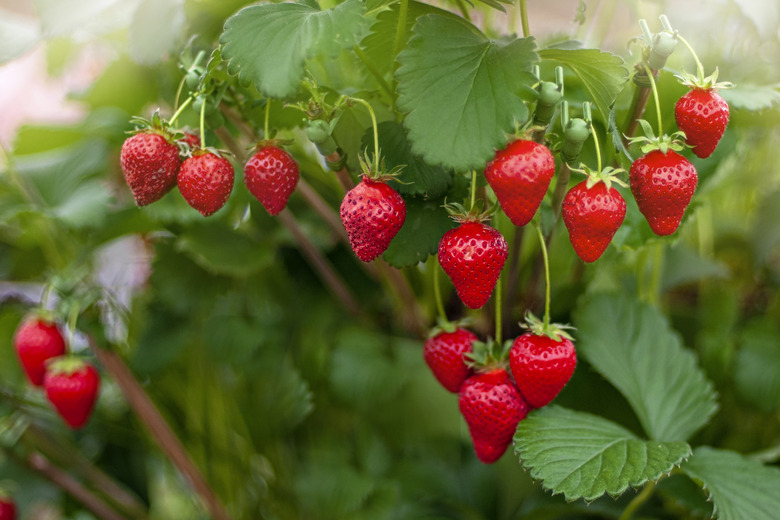Can You Grow Strawberries And Tomatoes In The Same Garden?
We may receive a commission on purchases made from links.
You can look forward to a summer of incredible meals when you grow strawberries (Fragaria x ananassa, USDA zones 5-9) and tomatoes (Lycopersicon esculentum, USDA zones 10-11) in the same garden. Tomatoes and cultivated strawberries are extremely common garden plants, yet they can create problems for each other when planted too closely together. The good news is that with careful planning and management before and during the growing season, you can have both plants in the same garden.
Tip
It's possible to successfully grow strawberries and tomatoes in the same garden, though their mutual susceptibility to certain diseases means these plants do best with some distance between them.
Strawberries and Tomatoes: Disease Issues
Strawberries and Tomatoes: Disease Issues
Tomatoes and strawberries are from very different plant families. They have drastically different growing habits and almost diametrically opposed environmental requirements. For instance, even though tomatoes are tender perennials only hardy in USDA zones 10-11, they're usually grown as annual plants; they cease fruit production below 55 degrees Fahrenheit and die when exposed to frost. Strawberries, however, grow as perennials in USDA zones 5 through 9, which cover many parts of the United States.
Despite their differences, the two plants suffer from some of the same diseases, such as Verticillium wilt and anthracnose. Their mutual susceptibility to certain diseases is one of the biggest reasons why conventional wisdom advises that tomatoes and strawberries not be planted in the same garden, or at least far apart from each other.
However, for gardeners determined to grow strawberries and tomatoes in the same garden, disease issues can be controlled in a few ways.
- Plant tomatoes and strawberries as far apart as possible in the same garden. The greater the distance between them, the less the chance of accidental cross-contamination if one of the plants becomes diseased.
- Select only tomato and strawberry cultivars that are resistant to the diseases that are prevalent in your area. If, for instance, Verticillium wilt or anthracnose are problematic for either crop in your location, then use only anthracnose-resistant and Verticillium wilt-resistant varieties of both plants.
- Minimize the environmental conditions that allow the diseases to proliferate. For instance, most fungal diseases flare up during high-humidity and still-air conditions. Covering both crops during damp weather will keep their leaves dry and much less prone to disease. Removing the covering during dry weather, or encouraging air movement underneath the covering, will help further.
- For both indoor and outdoor plants, irrigating at soil level via drip irrigation or soaker hoses helps to keep leaves dry and disease-free.
Strawberries and Tomatoes: Pest Issues
Strawberries and Tomatoes: Pest Issues
Many people enjoy a big, red, ripe tomato fruit, or a big, red, ripe strawberry fruit. Unfortunately, so do many birds, mammals and insects. It seems every creature in the neighborhood wants fresh fruits before those fruits can be harvested. Pests attracted to a garden by either tomato or strawberry plants often will dine on both kinds. Fortunately, some strategies can protect tomato and strawberry plants.
- Use floating row covers to keep out insects and birds. Some floating row covers, such as certain ones made of polyester, are light enough to lay on top of plants without crushing them, but the covers' sides need to be anchored to hold the covers in place during breezy conditions. Floating row covers that are plastic film need to be held on hoops above plants. Whatever kind of floating row covers you use, remove the covers on good-weather days so that pollinatorscan reach your plants in the flowering stage.
- Plant trap crops, which will draw target pests away from the strawberries and tomatoes. First identify which pests are most likely to damage tomato or strawberry plants in your area, then select the appropriate trap crops for those pests. Alternatively, plant repellent crops beside or among the strawberries and tomatoes. For instance, the annual plants French marigold (Tagetes patula) and nasturtium (Tropaeolum majus) may provide mild to moderate protection against a variety of insect pests. Also, many aromatic herb plants either deter pests or cover their scent with their own.
Ideas for Companion Planting
Ideas for Companion Planting
Even though strawberries and tomatoes are not companion plants for each other, they each have companion plants that can benefit their growth. For instance, tomatoes and carrots (Daucus carota var. sativus) do very well when planted near each other. So if carrots are also in your garden plan, try to put them as close to the tomatoes as possible. Similarly, strawberries do very well near lettuce (Lactuca sativa) and spinach (Spinacia oleracea).
References
- Clemson Cooperative Extension Home & Garden Information Center: Tomato Diseases and Disorders
- Burpee: Companion Planting Guide
- Clemson Cooperative Extension Home & Garden Information Center: Growing Strawberries
- The National Gardening Association: Edible Landscaping – Growing Strawberries in Small Spaces
- Bonnie Plants: Growing Tomatoes
- University of Minnesota Extension: Growing Strawberries in the Home Garden
